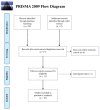Platelet-Rich Plasma for Patients with Olfactory Dysfunction: Myth or Reality? A Systematic Review
- PMID: 38337476
- PMCID: PMC10856510
- DOI: 10.3390/jcm13030782
Platelet-Rich Plasma for Patients with Olfactory Dysfunction: Myth or Reality? A Systematic Review
Abstract
Background: With promising outcomes, platelet-rich plasma (PRP) has recently been suggested as a treatment for olfactory dysfunction (OD).
Methods: Clinical studies utilizing PRP in OD caused by COVID-19, trauma, anesthetic exposure, viral infection, and chronic rhinosinusitis were included in a systematic review.
Results: Ten clinical studies were qualitatively analyzed. Six of these studies used the PRP for OD caused by COVID-19, one on OD after functional endoscopic sinus surgery, and three on post-infectious or post-trauma OD. The population included 531 patients, ranging in age from 15 to 63.
Conclusion: The use of PRP may be a risk-free and efficient therapeutic option with very encouraging outcomes. Indeed, it enhances olfactory perception in patients who not only exhibit COVID-19 infection aftereffects, but also in those who have lost their sense of smell due to trauma, rhinosinusitis, rhinitis, or even surgery. To evaluate the PRP's therapeutic benefits in OD patients and to compare the efficacy of different therapeutic protocols with regard to treatment schedules, there is an urgent need for focused controlled trials.
Keywords: COVID-19; anosmia; olfactory dysfunction; platelet-rich plasma; smell loss.
Conflict of interest statement
The authors declare no conflicts of interest.
Figures
Similar articles
-
Platelet-Rich Plasma (PRP) in the Treatment of Long COVID Olfactory Disorders: A Comprehensive Review.Biomedicines. 2024 Apr 5;12(4):808. doi: 10.3390/biomedicines12040808. Biomedicines. 2024. PMID: 38672163 Free PMC article. Review.
-
The use of Platelet rich Plasma in COVID-19 Induced Olfactory Dysfunction: Systematic Review.Indian J Otolaryngol Head Neck Surg. 2023 Jun 10;75(4):1-5. doi: 10.1007/s12070-023-03938-4. Online ahead of print. Indian J Otolaryngol Head Neck Surg. 2023. PMID: 37362129 Free PMC article.
-
Platelet-rich plasma for the treatment of COVID-19 related olfactory dysfunction: a systematic review.Rhinology. 2023 Dec 1;61(6):498-507. doi: 10.4193/Rhin23.168. Rhinology. 2023. PMID: 37772881
-
Platelet-rich plasma injection in the olfactory clefts of COVID-19 patients with long-term olfactory dysfunction.Eur Arch Otorhinolaryngol. 2023 May;280(5):2351-2358. doi: 10.1007/s00405-022-07788-8. Epub 2022 Dec 15. Eur Arch Otorhinolaryngol. 2023. PMID: 36520209 Free PMC article.
-
Topical platelet-rich plasma as a possible treatment for olfactory dysfunction-A randomized controlled trial.Int Forum Allergy Rhinol. 2024 Sep;14(9):1455-1464. doi: 10.1002/alr.23363. Epub 2024 May 9. Int Forum Allergy Rhinol. 2024. PMID: 38722276 Clinical Trial.
Cited by
-
Platelet-Rich Plasma (PRP) in the Treatment of Long COVID Olfactory Disorders: A Comprehensive Review.Biomedicines. 2024 Apr 5;12(4):808. doi: 10.3390/biomedicines12040808. Biomedicines. 2024. PMID: 38672163 Free PMC article. Review.
References
-
- Alkholaiwi F.M., Altamimi A.F., Almalki H.H., Almughaiseeb F.A., Alsubaie S.S., Alsayahi H.S., Alhijli F.W., Alobaishi R.S., Agrawal A., Alqahtani Z.A., et al. Olfactory dysfunction among patients with COVID-19. Saudi Med. J. 2023;44:1085–1103. doi: 10.15537/smj.2023.44.11.20230264. - DOI - PMC - PubMed
Publication types
LinkOut - more resources
Full Text Sources
Research Materials


